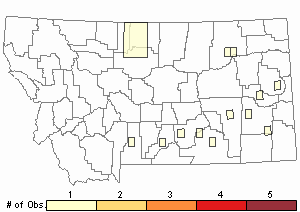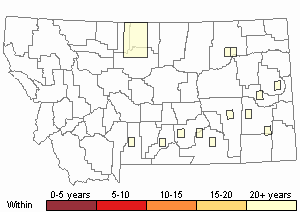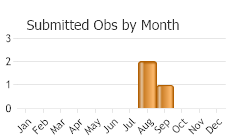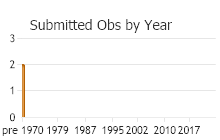View in other NatureServe Network Field Guides
NatureServe
Montana
Utah
Wyoming
Idaho
Wisconsin
British Columbia
South Carolina
Yukon
California
New York
Sagebrush Grasshopper - Melanoplus bowditchi
General Description
The following is taken from Brooks (1958), Vickery and Kevan (1985), Pfadt (2002), Capinera et al. (2004), Capinera and Sechrist (1982), and Scott (2010). A small to medium grasshopper, gray, bluish-gray, or reddish brown in color. A dark stripe extends from the back of the eye across the lateral lobes of the pronotum. The wings are long and extend 3 to 5 mm beyond the abdomen tip and bear a few fine dark spots along the mid-line.
Phenology
The Sagebrush Grasshopper overwinter in the egg stage. Upon hatching, the nymphs pass through 5 instars, and adults begin to appear during the first weeks of July. They occur from July to September (Capinera and Sechrist 1982, Scott 2010, and Vickery and Kevan 1985).
Diagnostic Characteristics
Taken from Brooks (1958), Vickery and Kevan (1985), Pfadt (2002), Capinera et al. (2004), Capinera and Sechrist (1982), and Scott (2010). The body length to end of forewings for males is 19 to 23 mm, and females 22 to 26 mm. Hind femur outer face is marked with chevrons separated by white lines. The hind tibia is blue. Examining the male genitalia and aedeagus is essential for identifying this species.
Any number of
Melanoplus species can be confused with this species without collecting male specimens for genitalia comparisons to make positive identifications. This species is almost identical to the
Yellowish Spur-throat Grasshopper (
M. flavidus). The wing (tegmina) tends to be more spotted in
M. bowditchi, and its aedeagus is not cup-shaped at the tip (Capinera and Sechrist 1982).
Species Range
Montana Range
Range Descriptions

 Native
Native
Range Comments
A western species distributed in grasslands, mountain valleys and foothills. From the Rocky Mountain front eastward to the Great Plains, southward from Alberta and Saskatchewan to northern Mexico. In Montana, there are confirmed reports for 19 counties in the eastern two-thirds of the state (Vickery and Kevan 1985, Pfadt 2002, Capinera et al. 2004, Capinera and Sechrist 1982, and Scott 2010).
Observations in Montana Natural Heritage Program Database
Number of Observations: 13
(Click on the following maps and charts to see full sized version)
Map Help and Descriptions
Relative Density

Recency


 (Observations spanning multiple months or years are excluded from time charts)
(Observations spanning multiple months or years are excluded from time charts)
Habitat
Inhabits mixed grass, short grass, desert, bunchgrass prairies, and dry open woodlands. Within these habitats, its distribution largely depends upon the presence of sagebrush, Artemisia (Pfadt 2002, Capinera et al. 2004, and Capinera and Sechrist 1982).
Food Habits
Feeds almost exclusively upon several species of sagebrush. Of six species, it favors
silver sagebrush (
Artemisia cana), and Sand sagebrush,
A. filifolia (Capinera and Sechrist 1982, Pfadt 2002, and Vickery and Kevan 1985).
Reproductive Characteristics
No observations have been made in nature relative to its courtship, mating, and oviposition. Egg pods are surrounded by a froth, surrounding a cluster of 12 to 13 eggs (Pfadt 2002).
Stewardship Responsibility
References
- Literature Cited AboveLegend:
 View Online Publication
View Online Publication Brooks, A.R. 1958. Acridoidea of Southern Alberta, Saskatchewan, and Manitoba (Orthoptera). The Canadian Entomologist (Supplement 9) 90:5-92.
Brooks, A.R. 1958. Acridoidea of Southern Alberta, Saskatchewan, and Manitoba (Orthoptera). The Canadian Entomologist (Supplement 9) 90:5-92. Capinera, J.L. and T.S. Sechrist. 1982. Grasshoppers of Colorado: Identification, Biology, and Management. Fort Collins, CO: Colorado State University Experiment Station, Bulletin 584S. 161 p.
Capinera, J.L. and T.S. Sechrist. 1982. Grasshoppers of Colorado: Identification, Biology, and Management. Fort Collins, CO: Colorado State University Experiment Station, Bulletin 584S. 161 p. Capinera, J.L., R.D. Scott, and T.J. Walker. 2004. Field Guide to Grasshoppers, Katydids, and Crickets of the United States. Ithaca, NY. Cornell University Press.
Capinera, J.L., R.D. Scott, and T.J. Walker. 2004. Field Guide to Grasshoppers, Katydids, and Crickets of the United States. Ithaca, NY. Cornell University Press. Pfadt, R.E. 2002. Field Guide to Common Western Grasshoppers, 3rd edition. Laramie, WY: Wyoming Agricultural Experiment Station, Bulletin 912, modified by S. Schell and S. Schell for electronic publication. Accessed 19 February 2020. http://www.uwyo.edu/entomology/grasshoppers/field-guide/index.html#fieldguidetoc
Pfadt, R.E. 2002. Field Guide to Common Western Grasshoppers, 3rd edition. Laramie, WY: Wyoming Agricultural Experiment Station, Bulletin 912, modified by S. Schell and S. Schell for electronic publication. Accessed 19 February 2020. http://www.uwyo.edu/entomology/grasshoppers/field-guide/index.html#fieldguidetoc Scott, R.D. 2010. Montana Grasshoppers, Katydids, and Crickets A Pictorial Field Guide to the Orthoptera. MagpieMTGraphics, Billings, MT.
Scott, R.D. 2010. Montana Grasshoppers, Katydids, and Crickets A Pictorial Field Guide to the Orthoptera. MagpieMTGraphics, Billings, MT. Vickery, V. R. and D. K. M. Kevan. 1985. The grasshopper, crickets, and related insects of Canada and adjacent regions. Biosystematics Research Institute, Ottawa, Ontario. Publication Number 1777. 918 pp.
Vickery, V. R. and D. K. M. Kevan. 1985. The grasshopper, crickets, and related insects of Canada and adjacent regions. Biosystematics Research Institute, Ottawa, Ontario. Publication Number 1777. 918 pp.
- Additional ReferencesLegend:
 View Online Publication
View Online Publication
Do you know of a citation we're missing? Anderson, N.L. 1951. Field studies on the biology of range grasshoppers of southeastern Montana. M.Sc. Thesis. Bozeman, Montana: Montana State University. 96 p.
Anderson, N.L. 1951. Field studies on the biology of range grasshoppers of southeastern Montana. M.Sc. Thesis. Bozeman, Montana: Montana State University. 96 p. Anderson, N.L. 1962. Grasshopper-vegetation relationships on Montana grasslands. Ph.D Dissertation. Bozeman, Montana: Montana State University. 73 p.
Anderson, N.L. 1962. Grasshopper-vegetation relationships on Montana grasslands. Ph.D Dissertation. Bozeman, Montana: Montana State University. 73 p. Hebard, M. 1928. The Orthoptera of Montana. Proceedings of the Academy of Natural Sciences of Philadelphia, Vol. 80:211-306.
Hebard, M. 1928. The Orthoptera of Montana. Proceedings of the Academy of Natural Sciences of Philadelphia, Vol. 80:211-306. Hebard, M. 1932. Notes on Montana Orthoptera. Proceedings of the Academy of Natural Sciences of Philadelphia. V. 84. pp 251-257.
Hebard, M. 1932. Notes on Montana Orthoptera. Proceedings of the Academy of Natural Sciences of Philadelphia. V. 84. pp 251-257. Skinner, K.F. 1995. Plant and grasshopper community composition: indicators & interactions across three spatial scales. M.Sc. Thesis. Bozeman, MT: Montana State University. 144 p.
Skinner, K.F. 1995. Plant and grasshopper community composition: indicators & interactions across three spatial scales. M.Sc. Thesis. Bozeman, MT: Montana State University. 144 p.
- Web Search Engines for Articles on "Sagebrush Grasshopper"
- Additional Sources of Information Related to "Insects"





